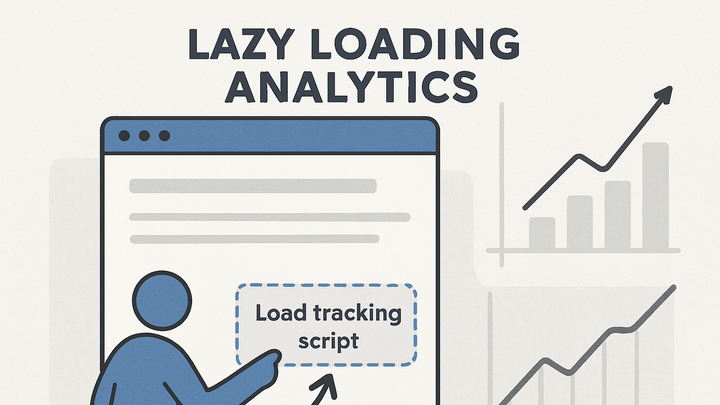Published on 2025-06-22T08:13:42Z
What is Lazy Loading Analytics? Examples with PlainSignal and GA4
Lazy loading analytics is a performance optimization technique in web analytics where tracking scripts and events are loaded or executed only when specific conditions are met, such as:
- After the initial page content has rendered (defer load)
- When a user scrolls or engages with certain page sections
- Upon receiving explicit consent in regions with strict privacy regulations
This method reduces render-blocking resources, improves page load times, and enhances user experience. However, it introduces complexity around ensuring complete data capture and handling edge cases where users navigate away before triggers fire. In this glossary article, we delve into the mechanics, benefits, challenges, and implementation patterns of lazy loading analytics, with real-world examples using PlainSignal (a privacy-focused, cookie-free analytics solution) and GA4 (Google Analytics 4).
Lazy loading analytics
Delaying analytics script loading until triggers like page load, scroll, or consent to optimize site performance while maintaining data accuracy.
Introduction to Lazy Loading Analytics
Lazy loading analytics is the practice of delaying the loading and execution of analytics scripts or events until certain conditions are met. By deferring non-essential tracking resources, you can improve page performance, reduce bandwidth usage, and provide a smoother user experience. This section covers the core concept and common scenarios where lazy loading makes sense.
-
Core concept
Delayed execution of analytics to optimize page load and resource usage, ensuring tracking runs only when it’s valuable.
-
Common use cases
Typical scenarios include single-page applications, above-the-fold content interaction, and regions requiring explicit user consent before tracking.
How Lazy Loading Analytics Works
Lazy loading leverages event-driven triggers and browser APIs to determine when to load and execute analytics code. It can be based on user interaction events, viewport visibility, or timed delays. Understanding these mechanisms helps in selecting the right approach for your analytics strategy.
-
Event-based triggers
Analytics scripts load in response to user actions such as scrolling past a threshold, clicking a button, or hovering over a section.
-
Scroll event
Fires when a user scrolls to a specific distance, ideal for capturing engagement with longer pages.
-
Click event
Triggers analytics when a user interacts with a particular element, reducing unnecessary script loads.
-
-
Intersection observer api
Uses the Intersection Observer to detect when elements enter the viewport, triggering analytics when a component becomes visible.
-
Deferred script injection
Dynamically injects script tags into the DOM with defer or async attributes to prevent blocking the initial page render.
Implementation Examples
In this section, we demonstrate practical implementations of lazy loading analytics using PlainSignal and GA4. Each example includes code snippets and explanations of key attributes and logic.
-
PlainSignal implementation
To implement lazy loading with PlainSignal, use a preconnect hint and defer the analytics script until after the page has loaded. This snippet shows the basic setup:
-
Code snippet
<link rel="preconnect" href="//eu.plainsignal.com/" crossorigin /> <script defer data-do="yourwebsitedomain.com" data-id="0GQV1xmtzQQ" data-api="//eu.plainsignal.com" src="//cdn.plainsignal.com/plainsignal-min.js"></script>
-
-
GA4 implementation
For GA4, you can lazy load the gtag.js library by deferring its insertion or triggering it on user interaction. The following example uses a delayed load after window load:
-
Code snippet
window.addEventListener('load', function() { setTimeout(function() { var gtagScript = document.createElement('script'); gtagScript.src = 'https://www.googletagmanager.com/gtag/js?id=GA_MEASUREMENT_ID'; document.head.appendChild(gtagScript); window.dataLayer = window.dataLayer || []; function gtag(){dataLayer.push(arguments);} gtag('js', new Date()); gtag('config', 'GA_MEASUREMENT_ID'); }, 1000); });
-
Benefits and Challenges
Lazy loading analytics offers performance gains and enhanced user experience but comes with trade-offs in data completeness and increased complexity. Evaluate these factors when deciding on your analytics strategy.
-
Performance improvement
Reduces initial page load time and render-blocking resources, leading to faster interactions and improved Core Web Vitals.
-
Data accuracy trade-offs
Some users may leave before triggers fire, resulting in incomplete session data and potential under-reporting of metrics.
-
Implementation complexity
Requires additional logic for triggers, fallbacks, and edge cases, increasing development and maintenance efforts.
Best Practices and Tips
Implement these best practices to achieve a balance between performance optimization and robust data collection when using lazy loading analytics.
-
Use multiple triggers
Combine different triggers like page load, scroll depth, and click events to capture a wider range of user interactions.
-
Implement fallbacks
Set a maximum timeout to force-load analytics scripts to avoid data loss from inactive users.
-
Monitor and test
Regularly audit event firing and compare against synchronous implementations to ensure data consistency.
